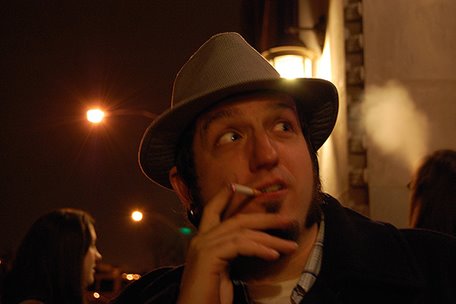After work one day last week I didn't quite feel like going home, so I walked up to the shopping district around the Hancock building. It was a spontaneous outing but my current contract is very close to that area of Chicago, just a few blocks. As I got closer I started to get kind of excited though. I'd been in the Hancock/Water Tower district of Chicago many times but had never really paid this much attention. I found myself looking down at my feet while I walked over every crosswalk, stopping sometimes to inspect an anomalous bit of tar on the asphalt. As I walked around, passing intersections I knew once had tiles, I could see tiny remnants at best. I found myself questioning whether I'd seen what I'd seen, little scraps of blackened tar without the distinctive lettering of one of the tiles. All the while I was marveling at how many people were surrounding me, how many cars were passing, and just how busy this part of Chicago is all the time. How could he, the one responsible, have successfully placed so many in this, the busiest part of Chicago? It truly is an amazing achievement that he was never caught in the act. All we have of his identity is whispers in the media from the 1970s and an address in Philadelphia (from the Santiago, Chile tiles) that is probably wrong.
I was close to giving up on the search. The city of Chicago has stated that they see the tiles as vandalism (a difference of opinion they have with Philadelphia, the likely birthplace of the tiles, where they are seen as being worthy of some preservation), so most likely they were all destroyed by the time I set about my search. I did find one, though, at the next-to-last location I would search. Just barely visible on the northmost edge of the northmost stripe of the crosswalk between Water Tower Place and the Hancock building were the words "TOYNBEE IDEA".
It was that moment that I had been seeking, the moment when this phenomenon I'd only read about became a real, tangible thing. I don't know how old the tile was, nor how just that one line of it had survived and the rest had gone away, but I was thankful to see my momentary obsession rewarded. The tile looked like it was made with hardened modeling clay and despite its age the colours in the type still contrasted neatly with the white of the crosswalk stripe, and with the white backing of the tile. I knew from my research that it was made of true linoleum—apparently difficult to come by in the United States—and despite the sloppiness of the letters they were at least consistent across tiles. They looked as though they'd been fabricated and placed very carefully just there. There was purpose to it, as though the tiler had wanted his work to be as visible as possible. Yet he put them all on streets where no one looks down.
If the tiler was indeed insane—and I think by the paranoid inscriptions frequently found beneath tiles he probably was—I would at least like to know what idea it was he was trying to spread. The idea of resurrecting the dead on Jupiter is so outside the realm of possibility that it bears no consideration, but what if there's a shallower meaning behind all of it, and the tile text is inconsequential to that? Perhaps it's his attempt at metaphor.
I don't think we'll ever know.


No comments:
Post a Comment